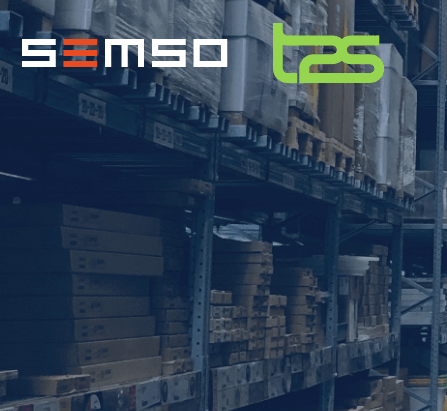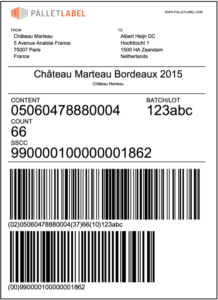SSCC label API integration
Are your trading partners requesting SSCC labels for your pallet shipments? Would you like to automate this process and generate labels directly from your IT system? Then the SSCC Label API connection is right for you.
Automate your workflow
An API connection could save your organization a lot of time. Still manually typing/copying your SSCC codes into your IT system? Editing your electronic packing slip (DESADV) to add these SSCC codes? Using the API all these activities can be fully automated.
On top of that you will no longer need to manually design labels based on your clients’ specifications. No more worrying about how to generate the needed barcodes, and whether you meet all label requirements.
Save time and money
By connecting your IT systems using an API, you will save time and money. It will be no longer needed to maintain and input data in different systems. The API connection optimizes processes and increases efficiency in your workflow.
Exact & SSCC
We have good news for everyone that works with Exact Online and Exact Globe. Together with our partner Semso we can offer an integrated solution for your SSCC labels and EDI messages. Want to know more? Contact us or Semso. Together we’ve realized several implementations for customers that use Exact.
Different IT system?
Most ERP or Warehouse Management Systems support API connections. We’ve set up integrations with, for example, organizations using MS Dynamics 365.
EDI Platform
Besides the SSCC label API we also have an EDI platform for integration with IT systems. You can find out more about this by clicking on the button below.

Benefits of the SSCC label API connection
By automating the generation of SSCC labels using an API that’s connected to your system, you’ll save yourself time and effort. You can start using this standard flexible building block immediately without having to program your own labeling system.
Secure, fast, and accurate
You don’t have to worry about the safety of the API. The SSCC label API uses standard authorization methods and encryption (Oauth 2.0). After the connection is set up, you can generate labels swiftly, safely, and precisely in an automated manner.
Printing labels
The API generates the label and you’ll be able to either receive the label in PDF or a label request file in json format. The API generates a GS1 compliant SSCC label in no time, that also meets your customers’ requirements.
The label request file that’s returned by the API can be processed by One2Label Automation. One2Label Automation sends a label job directly and without delay to your Zebra printer.
- Save time and money
- Direct connection between your systems and the SSCC-label API
- No programming required
- Exchange data in real-time
- Digitize your processes
- Fast, secure, and accurate
The label layout
Homogeneous pallets
The default size of an SSCC label is A5 (148 x 210 mm). On one pallet, place two identical SSCC labels on both sides of the pallet.
Heterogeneous pallets
Each layer of a mixed pallet or heterogeneous pallet is considered to be an independent logistic unit. Therefore, each layer of a heterogeneous pallet must be identified with its own unique SSCC label.
Single or double layout?
During the SSCC label API implementation you can choose the layout you require: double A5 or single A5. This choice is determined by the type of paper used in your printer.
If you use a roll of A5 labels, you will need the single A5 layout. If you use A4 sheets (Avery 3655) with two A5 labels on each A4 sheet, you will need the double A5 layout.
Printing SSCC labels
If you have selected the double A5 layout, you print the label created by the API once and get two identical A5 SSCC labels. You can place these labels on both sides of the pallet.
If you have selected the single A5 layout, you print the label created by the API twice to get two identical A5 SSCC labels. You can place these labels on both sides of the pallet.
More information on SSCC
We have a knowledge database on our site www.palletlabel.com which contains all the information you need on SSCC codes, the GS1 standard, the SSCC label and more.
You can even create an example GS1 logistics label using the available demo.

EDI API Connection
The SSCC Label API can be combined with the EDI API connector.
The EDI API connector communicates all EDI messages such as DESADV, ORDERS and INVOIC with your trading partners based on the data in your IT system.
Data delivery can be done in any format you’d like. We’ll handle the transformation, validation and routing of your messages.
On top of that we’ll ensure the messages meet the GS1 standard and all requirements set by you and your customers. Fast, secure and accurate.
Curious about the possibilities?
Questions about SSCC labels, EDI, or the integration options we have to offer? Please do not hesitate to contact us. We can be reached via phone and WhatsApp on +31 180 54 51 51. You could also email us at info@t2s.nl
Would you prefer that we contact you? No problem, simply fill in below form and we’ll get back to you.
Learn more about cloud labeling
Would you like more information about generating and printing SSCC labels from the cloud with API technology? Read more about it here.
Want to try our software?
Want to see for yourself how our SSCC label software works? Fill in your details below and receive a demo label in your email.
Frequently asked questions about an API
API is short for Application Programming Interface, and it’s an online service your systems can talk to.
An API enables systems and software the possibility to connect to another system. It provides an “entrance” to underlying software. Using this entrance other systems can communicate with the underlying software and exchange information.
An API isn’t visible to the person who uses the software. The API is a service that works in the background and performs its tasks by communicating with underlying software.
A number of the most important benefits of an API are; it enables better integration, it uses standardized communication methods, it enables real-time data exchange, smoothly running internal processes, operational and cost efficiency by reducing manual labor.
The differences aren’t that large, as both serve to enable digital collaboration. An API enables company B to grant access to company A to its software using an interface. When it comes to EDI, company A sends a digital message to company B requesting data or placing an order message (using the EDIFACT standard).